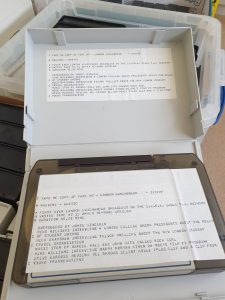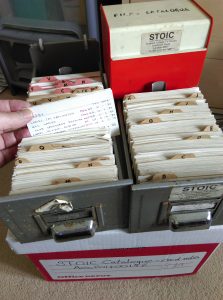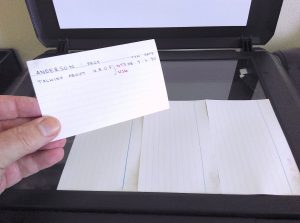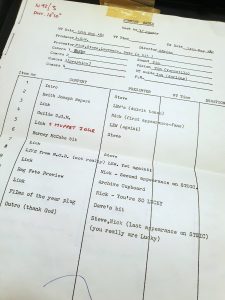Recently I had an email from STOIC’s first full-time videotape archivist (1980-1981) Colin Jenkins. The email reminded me of the huge contribution that the card index has made to college history, through videotape recordings. Sadly this is a fact that college does not appreciate or make use of and hence why this blog is maintained to showcase this valuable resource.
 Initially, and only for about ten videotapes, the indexing was started using the facilities of the college computer centre. Details were outputted on computer lined paper as can be seen in this photo. This printout then had to be cut and stuck inside the videotape box and also onto the actual videotape. I never was happy with this idea of sticking the printout onto the actual tapes in case they came off whilst inside the tape machine! The problem was that only the person who had created this computer account (and routine) could access the index. It soon became very clear that this was simply not possible to maintain as students came and went from college and their computer accounts were closed! A simple system was needed that could be accessed within the studio that didn’t require a computer centre account or terminal to be able to log on.
Initially, and only for about ten videotapes, the indexing was started using the facilities of the college computer centre. Details were outputted on computer lined paper as can be seen in this photo. This printout then had to be cut and stuck inside the videotape box and also onto the actual videotape. I never was happy with this idea of sticking the printout onto the actual tapes in case they came off whilst inside the tape machine! The problem was that only the person who had created this computer account (and routine) could access the index. It soon became very clear that this was simply not possible to maintain as students came and went from college and their computer accounts were closed! A simple system was needed that could be accessed within the studio that didn’t require a computer centre account or terminal to be able to log on.
 So, what could be more simple than the good old card index. Initially, using a single draw card index file, the new system was started by Colin Jenkins, simply known to us all as CJ. The new way of indexing and archiving was changed at the beginning of recordings being made on the U-matic tape system (Autumn term 1979). This itself is interesting because up until then videotapes were recorded over each week and therefore previous programmes were lost for ever. This was due to of the high cost of videotapes. U-matics were a lot cheaper to buy and an increased budget allowed STOIC to start keeping, and thus archiving, all programmes made. It also meant less potential wear on the tape machines when using the same tapes over and over again each week.
So, what could be more simple than the good old card index. Initially, using a single draw card index file, the new system was started by Colin Jenkins, simply known to us all as CJ. The new way of indexing and archiving was changed at the beginning of recordings being made on the U-matic tape system (Autumn term 1979). This itself is interesting because up until then videotapes were recorded over each week and therefore previous programmes were lost for ever. This was due to of the high cost of videotapes. U-matics were a lot cheaper to buy and an increased budget allowed STOIC to start keeping, and thus archiving, all programmes made. It also meant less potential wear on the tape machines when using the same tapes over and over again each week.
 I have now completed a simple backup of the entire card index by scanning every card into a PDF file. It would be desirable to collate these into something like an Excel or Word file, but that isn’t really necessary for this use – keep it simple. Because the indexing was now maintained within the file system draws, a way was still needed to present data within the actual tape box (as in the original computer printout idea). I suggested that the programme running orders, that were used for each programme, be held within each tape box.
I have now completed a simple backup of the entire card index by scanning every card into a PDF file. It would be desirable to collate these into something like an Excel or Word file, but that isn’t really necessary for this use – keep it simple. Because the indexing was now maintained within the file system draws, a way was still needed to present data within the actual tape box (as in the original computer printout idea). I suggested that the programme running orders, that were used for each programme, be held within each tape box.
 The programme running orders are now as valuable as the index in finding what was recorded onto the tape. Even last minute changes were written by hand and most of the basic information then added to either current or new index cards. The card index was never created to hold all of the information that can be found on the running orders. I’m pleased to say that even after CJ had left Imperial, the index continued. STOIC left the college TV studio after the end of term in 1986. From the index I can see that a few entries were made in 1987 but then things stopped. Therefore no record exists of programmes after that time and it will be a task to decipher content when running those tapes that exist from that period.
The programme running orders are now as valuable as the index in finding what was recorded onto the tape. Even last minute changes were written by hand and most of the basic information then added to either current or new index cards. The card index was never created to hold all of the information that can be found on the running orders. I’m pleased to say that even after CJ had left Imperial, the index continued. STOIC left the college TV studio after the end of term in 1986. From the index I can see that a few entries were made in 1987 but then things stopped. Therefore no record exists of programmes after that time and it will be a task to decipher content when running those tapes that exist from that period.
One final point is that some videotapes were kept prior to 1979. These video recordings were made on the Ampex Type A one-inch format and were also added to the card index. So technically we can go back to February 1970 when STOIC’s first news programme was made and the actual videotape was kept and added to the collection.
Colin Grimshaw July 2023